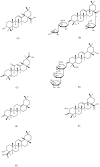The Role of Triterpenoids in Gastric Ulcer: Mechanisms and Therapeutic Potentials
- PMID: 40244034
- PMCID: PMC11990034
- DOI: 10.3390/ijms26073237
The Role of Triterpenoids in Gastric Ulcer: Mechanisms and Therapeutic Potentials
Abstract
Gastric ulcer (GU) is a prevalent gastrointestinal disorder impacting millions worldwide, with complex pathogenic mechanisms that may progress to severe illnesses. Conventional therapies relying on anti-secretory agents and antibiotics are constrained by drug abuse and increased bacterial resistance, highlighting the urgent need for safer therapeutic alternatives. Natural medicinal compounds, particularly triterpenoids derived from plants and herbs, have gained significant attention in recent years due to their favorable efficacy and reduced toxicity profiles. Emerging evidence indicates that triterpenoids exhibit potent anti-ulcer properties across various experimental models, modulating key pathways involved in inflammation, oxidative stress, apoptosis, and mucosal protection. Integrating current knowledge of these bioactive compounds facilitates the development of natural triterpenoids, addresses challenges in their clinical translation, deepens mechanistic understanding of GU pathogenesis, and drives innovation of therapeutic strategies for GU. This review comprehensively evaluates the progress of research on triterpenoids in GU treatment since 2000, discussing their biological sources, structural characteristics, pharmacological activities, and mechanisms of action, the animal models employed in the studies, current limitations, and the challenges associated with their clinical application.
Keywords: gastric ulcer; gastroprotective; pharmacological mechanism; triterpenoids.
Conflict of interest statement
The authors declare no conflicts of interest.
Figures













Similar articles
-
Microenvironment-responsive sodium alginate hydrogel loaded with MnO2 and pachymic acid for the treatment of gastric ulcer.Biomed Pharmacother. 2025 Feb;183:117835. doi: 10.1016/j.biopha.2025.117835. Epub 2025 Jan 20. Biomed Pharmacother. 2025. PMID: 39837214
-
Antiulcer mechanisms of Vernonia condensata Baker: A medicinal plant used in the treatment of gastritis and gastric ulcer.J Ethnopharmacol. 2016 May 26;184:196-207. doi: 10.1016/j.jep.2016.02.049. Epub 2016 Mar 5. J Ethnopharmacol. 2016. PMID: 26956376
-
Untargeted serum and gastric metabolomics and network pharmacology analysis reveal the superior efficacy of zingiberis rhizoma recens-/euodiae fructus-processed Coptidis Rhizoma on gastric ulcer rats.J Ethnopharmacol. 2024 Oct 5;332:118376. doi: 10.1016/j.jep.2024.118376. Epub 2024 May 22. J Ethnopharmacol. 2024. PMID: 38782310
-
Efficacy and safety of herbal medicines in treating gastric ulcer: a review.World J Gastroenterol. 2014 Dec 7;20(45):17020-8. doi: 10.3748/wjg.v20.i45.17020. World J Gastroenterol. 2014. PMID: 25493014 Free PMC article. Review.
-
Antioxidant properties of natural compounds used in popular medicine for gastric ulcers.Braz J Med Biol Res. 2002 May;35(5):523-34. doi: 10.1590/s0100-879x2002000500003. Braz J Med Biol Res. 2002. PMID: 12011936 Review.
References
-
- Hassan H.M., Alatawi N.M., Bagalagel A., Diri R., Noor A., Almasri D., Bakhsh H.T., Kutbi H.I., Ashy N., Al-Gayyar M.M.H. Genistein ameliorated experimentally induced gastric ulcer in rats via inhibiting gastric tissues fibrosis by modulating Wnt/β-catenin/TGF-β/PKB pathway. Redox Rep. 2023;28:2218679. doi: 10.1080/13510002.2023.2218679. - DOI - PMC - PubMed
-
- Zhou D., Yang Q., Tian T., Chang Y., Li Y., Duan L.R., Li H., Wang S.W. Gastroprotective effect of gallic acid against ethanol-induced gastric ulcer in rats: Involvement of the Nrf2/HO-1 signaling and anti-apoptosis role. Biomed. Pharmacother. 2020;126:110075. doi: 10.1016/j.biopha.2020.110075. - DOI - PubMed
-
- Guo Y., Wu Y., Huang T., Huang D., Zeng Q., Wang Z., Hu Y., Liang P., Chen H., Zheng Z., et al. Licorice flavonoid ameliorates ethanol-induced gastric ulcer in rats by suppressing apoptosis via PI3K/AKT signaling pathway. J. Ethnopharmacol. 2024;325:117739. doi: 10.1016/j.jep.2024.117739. - DOI - PubMed
Publication types
MeSH terms
Substances
Grants and funding
LinkOut - more resources
Full Text Sources

